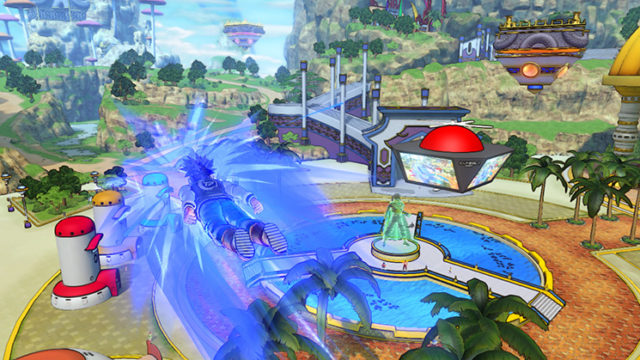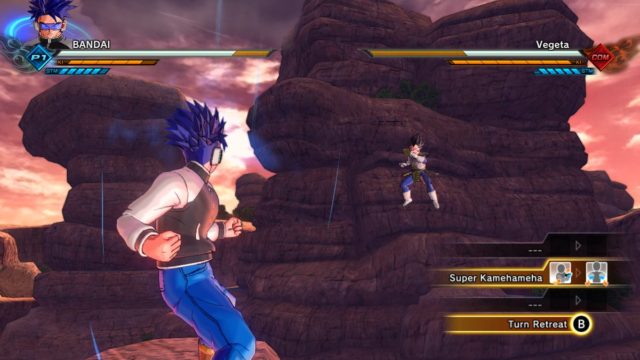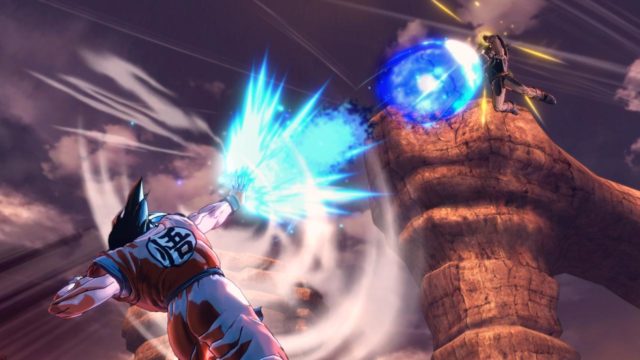True to form Dragon Ball battles; in-depth character customization and growth; cleverly reimagines and respects series lore; combat balances approachability and complexity well; dozens of hours of content with good replayability
Limited appeal to non-fans; unlocking all features takes too long to unlock; battles against too many foes can feel cheap; graphics lose their luster when not in motion
Ideally, a licensed video game can capture the heart and soul of its source material while presenting an enjoyable, well-made gameplay experience; accomplishing this within the realm of the celebrated and long-running Dragon Ball franchise must present quite a challenge. While many fighting games have been made with these familiar characters, locations, and stories, none have truly captured the manga and anime’s epic sense of adventure punctuated with ridiculously over-the-top fights that incorporate everything from intricate, light speed martial arts maneuvers to planet destroying energy blasts. Despite this considerable challenge, Dragon Ball Xenoverse 2 might be as compelling an adaptation as a fan could hope for, even if it had to cut a few gameplay corners in order to deliver the spectacle fans want.
Like many previous Dragon Ball adaptations, Xenoverse 2 is, at its core, a fighting game, but differs in its efforts to be so much more. Instead of trying to squeeze the series into a Street Fighter shaped box, the developers at Dimps have created a combat system that plays more like a third-person action game stuffed into an RPG-like structure with a heavy emphasis on customization and multiplayer. Xenoverse 2 isn’t just a series of battles replicating the series biggest moments, it’s a sprawling game filled with an impressive amount of content and numerous ways to approach it.
Right off the bat, you’re tasked with creating your own custom character belonging to one of five races: Human, Saiyan, Majin, Namekian, or Frieza’s Race with the first three offering a choice of gender. Beyond the obvious aesthetic differences, which can be customized to your liking, each of these permutations also differ in terms of base stats and perks as well as offer some unique armor and skills later on in the game. Your ability to tweak your character to your liking continues throughout the game as you acquire new gear which affects your stats and level up, which earns you skill points you can freely distribute among your six attributes: Health, Ki, Stamina, Basic Attacks, Strike Supers, and Ki Supers. You are also free to select our own slate of Super and Ultimate attacks as you unlock them, either through completing quests or purchasing them from vendors.

With your character squared away, you are thrust into the surprisingly clever story Xenoverse 2 has to tell, as well as the world in which it takes place. You play as an up-and-coming member of the Time Patrol, a group of elite warriors tasked with protecting history from those looking to interfere with the past in order to reshape the future. So, when a mysterious enemy shows up with a cast of villains drawn from the franchise’s many theatrical outings and tries interfering with the series’ timeline, it gives you the perfect excuse to insert yourself into the biggest and most important battles to guarantee the series’ official canon comes to fruition. This means fans will likely see where things are generally going, but the creators generally offset that feeling of familiarity with a generally lighthearted and humorous tone, though it does touch on a few more serious moments as certain characters encounter darker parts of their own history they wish they could change but instead have to fight to maintain. Altogether, the story does a solid job of respecting the source material while still doing a few fun and interesting things with it thanks to the clever time travel premise.
Outside of the main campaign, players are allowed to explore Conton City, a hub world that draws inspiration from the series’ rich history of unique locations and designs, from the rounded, sphere-like buildings created by Capsule Corp, to the villages of Namek. Here, you’ll be able to shop for healing items, new armor, and Super Attacks, browse through a number of available single and multiplayer side quests, or train with various characters to learn their signature moves. You’ll also find several Time Rifts around Conton City that allow you to meet up with certain individuals or groups from throughout the the Dragon Ball timeline in order to do quests with and/or for them; this means one minute you could be improving your relations with the Namekians by protecting their Dragon Balls from Frieza’s invading armies and the next you could actually be fighting your way through the ranks of said army. The option to play the game online adds additional flavor to the world as it allows you to access time-specific shops or participate in special events that pop up from time to time, such as battling incredibly powerful Raid bosses or defending against Frieza’s invading armies alongside other players.
Unfortunately, Conton City is not quite a gleaming utopia as it presents a few gameplay frustrations. Occasionally, you’ll receive notice of special training opportunities that are actually little more than annoying mini-games that involve dull scavenger hunts or delivering milk while skipping activities with rewards that don’t make the dull mechanics worthwhile. Also, it takes quite a while to gain access to the whole city as well as the activities it offers, as the ability to go online and freely fly about the environment are gated behind certain parts of the story mode. You’ll love having the ability to fly around Conton City at your leisure once you are allowed to take to the air, but it’s hard to think of a reason why you weren’t allowed to do it right from the start. Also, when playing with the Switch in handheld mode, the only time I ever experienced drops in the performance were when I was in this hub world, and they were quite noticeable. Aside from these hiccups, everything else seemed to run fine regardless of how I played the game.

As fun and interesting as Xenoverse 2‘s world and story are, the meat and potatoes of Dragon Ball has always been its battles, and this comes closer to capturing the look and feel of these epic confrontations than any previous adaptation. Mechanically, the battles in Xenoverse 2 require a certain level of finger gymnastics that makes it feel a little more complex than it really is. You’ll need to remember certain button combinations in order to fully access your arsenal of standard and special maneuvers, but they are generally much more simple and straightforward than the combos and inputs required from more serious, e-sport aspiring fighting games. What’s important to note is that these battles aren’t limited to two planes of movement; just like in the show, your characters will also take to the air and dart around one another as they punch, kick and throw energy blasts at one another. The action can appear hectic, but it really boils down to weak, strong, and ranged attacks intermixed with additional dodge and special attacks tied to your Stamina and Ki energy respectively. Stamina primarily builds up as you avoid confrontation and allows you to activate certain rush attacks as well as dodges that avoid enemy attacks while positioning you behind your foes. Ki builds up as you deal or receive damage and is needed to power your special and ultimate attacks. Additional skills exist that provide other ways for building up these bars.
The game also allows for the use of motion controls to pull off certain special attacks when playing with just the Joy-Cons. They work reasonably well and do a good job of imitating the corresponding hand motions featured in the shows, however they can be pulled off much more effectively with button presses.
Having a full, three-dimensional environment in which to move makes positioning incredibly important. Most environments present plenty of options for cover, and the fighting mechanics as well as the customization options allow for plenty of reasonable tactics with which to engage your foe. A high stamina fighter would be great for rushing forward while constantly dodging out of enemy combos to hit from the rear while it’s just as reasonable to build a Ki-heavy character who sits back while hurling massive energy beams. Or, you can always settle for something in between, because the combat system really does a great job of giving you options.
Unfortunately, having such an open and free flowing combat system does come with its faults. Fights are highly dependent on a lock-on mechanic thanks to the incredible mobility every fighter is afforded. Without it, most attacks would likely wind up hurting little more than open air. However, this also means battles can become more than a little hectic when battling groups of uneven numbers. While focusing on one fighter, it makes you incredibly vulnerable to being blindsided by other foes and while it takes little more than a flick of the right analog stick to change targets, selecting the proper foe is a little tough when you are taking on the entire Ginyu Force by yourself or battling an entire hoard of Saibamen. These complications can be made all the more frustrating when you consider your dodging mechanics, because the timing is based on the foe you are locked onto, so even if you see another enemy coming at you, your attempt to dodge will be moot if your reaction time for both the dodge and lock-on switch aren’t superhuman. Also, the fact that so many of your dodge and counter moves are locked to the Stamina and Ki gauges that deplete with each use means you can wind up being the victim of some especially long, and frustrating, juggles with literally no way of defending yourself.

It’s also worth noting that, prior to starting a battle, you are presented with a screen that displays your objectives, conditions for defeat, potential loot, and overall difficulty. For the most part, all of this is spot on, but sometimes the difficulty displayed seems to have been chosen at random. Occasionally, you’ll play a mission that feels properly rated, only to be blindsided by a ridiculously powerful foe who joins the fight at the last second and instantly wrecks you with an ultimate attack that knocks out half of your health. Story missions sometimes present a similar annoyance when you are tasked with fighting a foe you can’t truly beat right away for plot purposes, which means some enemies will retain a certain amount of health either until the mission dialogue finishes or you defeat another enemy first. Few things are more annoying than landing what should be a killer combo on an especially difficult foe only to discover they have plot armor so you need to continue holding them off for a few minutes while the story catches up with you.
Visually, Xenoverse 2 seems to continue the trend established with its gameplay; it works very well at the high level, but falters when it comes to the small details. While casually walking around Conton City, you’d be justified in stating the game doesn’t look very good. Yes, it’s very colorful and has an appropriately cartoony vibe, but textures are very simple and, aside from character models, the polygon counts are low. However, once you get the ability to fly, everything gels when you’re at altitude. During combat, these flaws aren’t nearly as noticeable: the camera is almost always moving and focused on the lovingly crafted character models, their stellar animations, and the beautiful effects created by flying energy beams and their ensuing explosions. And, as stated earlier, the game generally runs incredibly well on Switch, with only the hub world presenting noticeable issues while in handheld mode. Taken as a whole, the game can look underwhelming when standing still but, thankfully, the game is always action-packed when it counts the most and that’s when it looks its best.
In terms of how Xenoverse 2 sounds, your opinions will likely depend on how you feel about Dragon Ball as a whole; though if you aren’t a fan, you probably won’t be interested anyway! Fans, on the other hand, should be more than satisfied. The voice acting and delivery stays true to the tone of the source material with what appears to be all the major English voice actors reprising their roles. The sound effects might sound a little low-fi to the casual listener, but fans will once again find them reassuringly familiar. The soundtrack, on the other hand, is actually surprisingly varied with a wide selection of tracks representing almost every imaginable genre. Furthermore, you actually are free to choose which song you want playing in the hub world as well as what song you want playing in generic battles, though some quest and story fights have set music.
Were Dragon Ball Xenoverse 2 a serious fighting game trying to compete with the best the genre had to offer, its imbalances and frustrations would make it hard to recommend. However, this is a game that knows what it’s trying to do, and as a love letter to the world of Dragon Ball, it works incredibly well. Yes, anyone who delves deep into the game is bound to be annoyed with some cheap battles and mechanical faults, but it’s easier to forgive those issues when most of the problems stem less from poor design, and more from willing sacrifices made in an effort to capture the look and feel of the series’ iconic battles. This respect for the source material is further reinforced by the sheer amount of content; the campaign is of a respectable length and when combined with the many side quests and characters to train with, it all adds up to dozens of hours of content that many will likely find worth revisiting time and time again as they experiment with new character builds. Those completely unfamiliar with Dragon Ball may or may not be able to look past the faults to find a pretty decent game, but, to even a casual fan such as myself, Xenoverse 2 represents an incredibly fun game that succeeds both as an adaptation of the franchise, as well as a clever new addition to it.
Nintendojo was provided a copy of this game for review by a third party, though that does not affect our recommendation. For every review, Nintendojo uses a standard criteria.




 ShareThis
ShareThis





